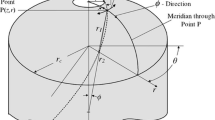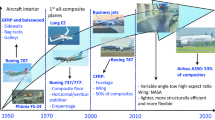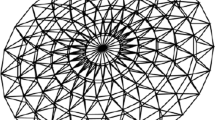Abstract
The main essential topic for the design of articulated pressure vessels is related to the determination of the optimal meridian profile. This article, aimed to present the new model for optimum design of dome contours for filament wound articulated pressure vessels based on non-geodesic trajectories. The current model is a mix of finite element analysis and inertia weight particle swarm optimization algorithm. Geometrical limitations, stability-ensuring winding conditions and the Tsai–Wu failure criterion have been used as optimization constraints. Classical lamination theory and non-geodesic trajectories are used to analyse the field stress equations and increase the structural performance. The geometry of dome contours is defined by the B-spline curves with twenty-one points. The results, when compared to the previously published results, indicate the efficiency of the presented model in achieving superior performance of dome shape for articulated pressure vessels. Also, it is shown that the design based on non-geodesic trajectories using this model gains better response than the design by geodesics type.











Similar content being viewed by others
References
S. Koussios, A. Beukers, O. Bergsma, in Isotensoid related composite structures. Proceedings of 21th Annual Conference of the ASC, Dearbon, September (2006)
H. Fukunaga, T.W. Chou, Simplified design techniques for laminated cylindrical pressure vessels under stiffness and strength constraints. J. Compos. Mater. 22, 1156–1169 (1983)
G. Divita, M. Marchetti, P. Moroni, P. Perugini, Designing complex-shape filament-wound structures. J. Compos. Manuf. 3, 53–58 (1992)
S. Adali, E.B. Summers, V.E. Verijenko, Optimization of laminated cylindrical pressure vessels under strength criterion. J. Compos. Struct. 25, 305–312 (1993)
M. Hojjati, A.V. Safavi, S.V. Hoa, Design of dome for polymeric composite pressure vessels. J. Compos. Eng. 5(1), 51–59 (1995)
C.C. Liang, H.W. Chen, C.H. Wang, Optimum design of dome contour for filament wound composite pressure vessels based on a shape factor. J. Compos. Struct. 58, 469–482 (2002)
S. Koussios, O. Bergsma, A. Beukers, in Isotensoid pressure vessels based on non-geodesic roving trajectories. Proceedings of 15th International Conference of Composite Materials, Durban (2005)
A. Vafaeesefat, A. Khani, Head shape and winding angle optimization of composite pressure vessel based on a multi level strategy. Appl. Compos. Mater. 14(5–6), 371–379 (2007)
L. Zu, S. Koussios, A. Beukers, Design of filament-wound domes based on continuum theory and non-geodesic roving trajectories. J. Compos. Struct. Part A 41, 1312–1320 (2009)
L. Zu, S. Koussios, A. Beukers, Shape optimization of filament wound articulated pressure vessels based on non-geodesic trajectories. J. Compos. Struct. 92, 339–346 (2010)
A. Paknahad, M.H. Hojjati, A. Fathi, in Dome design of composite pressure vessels using particle swarm optimization algorithm. 23th Canadian Congress of Applied Mechanics (2011)
S. Timoshenko, S. Woinowsky, Theory of Plates and Shells (McGraw-Hill Book Company, New York, 1989)
A.C. Ugural, Stresses in Plates and Shells (McGraw-Hill Book Company, New York, 1981)
M.R. Jones, Mechanics of Composite Material, 2nd edn. (Taylor and Francis, Philadelphia, 1999)
S.W. Tsai, E.M. Wu, A general theory of strength for anisotropic materials. J. Compos. Mater. 5, 58–80 (1971)
L. Zu, Design and optimization of filament wound composite pressure vessels (Uitgeverij BOXPress, Oisterwijk, 2012)
J. Kennedy, R.C. Eberhart, in Particle swarm optimization. IEEE International Conference on Neural Networks, pp. 1942–1948 (1995)
Y. Shi, R.C. Eberhart, in A modified particle swarm optimizer. IEEE Congress on Evolutionary Computation, pp. 69–73 (1998)
Acknowledgment
The authors appreciatively acknowledge Prof. Mohammad Hassan Hojjati for his helpful and valuable comments.
Author information
Authors and Affiliations
Corresponding author
Rights and permissions
About this article
Cite this article
Paknahad, A., Nourani, R. Mix Model of FE Method and IPSO Algorithm for Dome Shape Optimization of Articulated Pressure Vessels Considering the Effect of Non-geodesic Trajectories. J. Inst. Eng. India Ser. C 95, 151–158 (2014). https://doi.org/10.1007/s40032-014-0110-8
Received:
Accepted:
Published:
Issue Date:
DOI: https://doi.org/10.1007/s40032-014-0110-8




